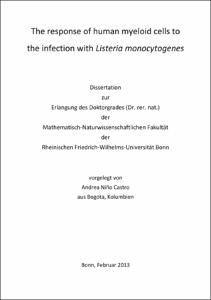The response of human myeloid cells to the infection with Listeria monocytogenes

The response of human myeloid cells to the infection with Listeria monocytogenes

| dc.contributor.advisor | Schultze, Joachim L. | |
| dc.contributor.author | Niño Castro, Andrea | |
| dc.date.accessioned | 2020-04-18T20:39:49Z | |
| dc.date.available | 2020-04-18T20:39:49Z | |
| dc.date.issued | 22.05.2013 | |
| dc.identifier.uri | https://hdl.handle.net/20.500.11811/5692 | |
| dc.description.abstract | Macrophages and dendritic cells (DC) constitute the first line of defense against invading microorganisms. These myeloid cells have been identified as the major components of the outer ringwall of suppurative granulomas present in patients with chronic listeriosis. macrophages and DC acquire diverse pro-inflammatory features in response to bacteria. However, using infection of in vitro generated professional phagocytes with Listeria monocytogenes (L.m.) as a model, it has been shown that macrophages like DC express a set of regulatory molecules in response to L.m. infection. This regulatory program comprises the expression of indoleamine 2,3-dioxygenase (IDO1), CD25 and IL-10. Moreover, the data indicated that this program has functional relevance since supernatants of infected macrophages suppressed T cell proliferation. In addition, whole transcriptome analysis has shown that macrophages and DC react to Listeria infection by inducing a common transcriptional program that includes proinflammatory and immunomodulatory mediators. Moreover, the data suggest that an important part of the transcriptional response of macrophages after L.m. infection is not tuned according to the level of threat represented by phagosome-restricted or fully competent bacteria. In line with these findings, I could show that around half of the transcriptional changes induced upon L.m. infection in macrophages are dependent on host factors mainly TNF-alpha and IFN-gamma, while the remaining 50% might be attributed to interactions between the host cell and viable invading bacteria. IDO1 has been recognized as an antimicrobial effector, essential in the defense against numerous pathogens. Herein I present data demonstrating that IDO1 is amongst the highest expressed genes and proteins after L.m. infection in human myeloid cells, including DC and macrophages. Several mechanisms such as IDO1-mediated tryptophan (Trp) depletion, but also accumulation of tryptophan catabolites have been associated with the antimicrobial effects of IDO1 expressing cells. The results obtained via IDO1 specific knockdown and enzymatic activity inhibition, have shown that human macrophages and DC use IDO1 to control the growth of cytosolic L.m. Furthermore, accumulation of tryptophan catabolites, but not Trp depletion has been identified as the main anti-bacterial mechanism in human myeloid cells against L.m. infection. In contrast to the important role exerted by IDO1 in human DC and macrophages, this protein was not induced in murine myeloid cells highlighting the specificity of host-pathogen interactions amongst species. | en |
| dc.language.iso | eng | |
| dc.rights | In Copyright | |
| dc.rights.uri | http://rightsstatements.org/vocab/InC/1.0/ | |
| dc.subject | dendritic cells | |
| dc.subject | macrophages | |
| dc.subject | Listeria monocytogenes infection | |
| dc.subject | transcriptional response | |
| dc.subject | IDO | |
| dc.subject | tryptophan catabolites | |
| dc.subject.ddc | 570 Biowissenschaften, Biologie | |
| dc.title | The response of human myeloid cells to the infection with Listeria monocytogenes | |
| dc.type | Dissertation oder Habilitation | |
| dc.publisher.name | Universitäts- und Landesbibliothek Bonn | |
| dc.publisher.location | Bonn | |
| dc.rights.accessRights | openAccess | |
| dc.identifier.urn | https://nbn-resolving.org/urn:nbn:de:hbz:5n-32248 | |
| ulbbn.pubtype | Erstveröffentlichung | |
| ulbbnediss.affiliation.name | Rheinische Friedrich-Wilhelms-Universität Bonn | |
| ulbbnediss.affiliation.location | Bonn | |
| ulbbnediss.thesis.level | Dissertation | |
| ulbbnediss.dissID | 3224 | |
| ulbbnediss.date.accepted | 08.05.2013 | |
| ulbbnediss.fakultaet | Mathematisch-Naturwissenschaftliche Fakultät | |
| dc.contributor.coReferee | Knolle, Percy A. |
Dateien zu dieser Ressource
Das Dokument erscheint in:
-
E-Dissertationen (4387)




